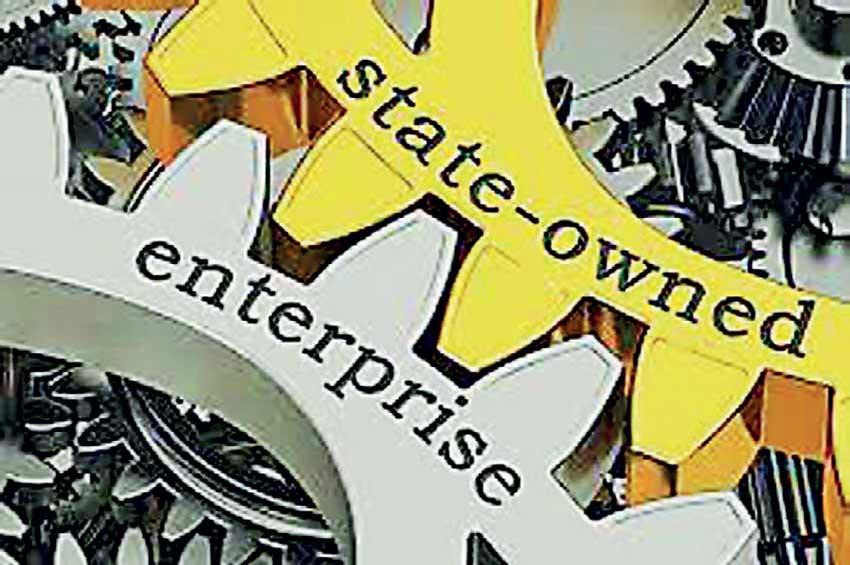27 Jul 2022 - {{hitsCtrl.values.hits}}

 It is clear to us all that Sri Lanka is in a state of crisis. You just need to see the queue at your local gas station for evidence of that. The core reasons for the crisis however, are a more contentious debate.
It is clear to us all that Sri Lanka is in a state of crisis. You just need to see the queue at your local gas station for evidence of that. The core reasons for the crisis however, are a more contentious debate.
Many may put the blame on the billions of rupees spent on vanity projects or on the corruption of successive regimes. It is true that these played a role but one of the true hidden killers in our economy is the bloated public sector and excessive government expenditure to support it. A key part of this is our massive, loss-making state-owned enterprises (SOEs).
The 52 ‘strategic’ SOEs alone had a cumulative loss of Rs.1.2 trillion (2006-2020), enough to pay for 24 Mattala Airports. Reforming SOEs should therefore be a top priority for the new administration.
Of the multitude of problems facing SOEs, four stand out in particular – the size of the workforce and limited incentive to perform, mismanagement and corruption and soft budgets and a lack of accountability. Any proposed reform should aim to address these issues and reduce the drain of government resources while improving the provision of services to the public.
What is Temasek?
Temasek Holdings Limited is a sovereign wealth fund (SWF) that acts as an independent holding company for SOEs and government-linked companies (GLCs). It was originally founded as a holding company for state-owned commercial enterprises but has since expanded (largely after a mandate shift in 2002) to become a strategic investment fund with international exposure.
Temasek has seen steady growth since its founding and is now worth over US $ 279 billion, with a 40-year compounded growth rate of 13 percent. The Temasek model refers to that of the ‘investment company model’ of sovereign wealth funds, wherein the government creates an investment company to manage assets and does not provide regular investment guidance to an asset manager (the ‘manager model’).
Following its independence in 1965, the government of Singapore aimed to boost development in the city-state by acquiring a minority stake in foreign investment projects and domestic start-ups. This both reduced the risk for investors and created the much-needed capital infusions. By the 1970s however, the government realised that there was a conflict of interest when the state acted as both a player and a regulator, which might deter start-ups and competition.
As a result, Temasek was established in 1974 to ensure neutrality and competitive market forces. Temasek was given an initial cash infusion and the ownership or minority stake in 35 GLCs (of which it today retains a stake in 12).
However, that was all the assistance it would receive; unlike in Sri Lanka, there was no preferential access to credit from state banks or guaranteed loans from the state/treasury. Singapore’s government neither interferes in Temasek’s board nor its operations and maintains the principles of non-intervention and non-preference.
Both the government and Temasek have made clear their preference for GLCs to be publicly listed to promote the good standards of governance required in listed companies. As a result, Temasek GLCs hold 37 percent of the value of the Singapore Exchange stock market. There is also a policy of non-preference towards GLCs. Therefore, Singapore’s GLCs remain highly profitable, have a better return-on-equity ratio and return-on-assets ratio and have valuations that on average, are higher than non-GLCs.
The advantage to the Singaporean people of retaining Temasek is seen in the Singapore Net Investment Return Contribution (NIRC). Fifty percent of the investment returns and 50 percent of the investment income from past returns of Singapore’s SWFs and central bank are added to the NIRC, which is used on government expenditure (and amounts to approximately a fifth of the annual budget). This allows the government to diversify its income and reduce its reliance on tax revenue.
How would Temasek work for us?
For Sri Lanka to follow the Temasek model, a holding company must be established with a competent board of directors and management and be given a sufficient cash infusion at the time of establishment. The government must make it absolutely clear to all stakeholders that it intends to follow the principles of non-interference and non-preference entirely.
It must be clear to the holding company that they are to be entirely self-financing. Funding in the early stages of development will likely be sourced from divestment proceeds as various SOEs are either corporatized (with unproductive assets auctioned off) or the firm itself sold off, as the board sees fit.
In the interest of stemming losses and ensuring a smooth transition for all SOEs in the near future, the government can begin corporatisation reforms immediately – particularly for the five largest loss-making SOEs.
Although the board of directors of Temasek and the political elite of Singapore were intertwined, it would be unwise to pursue this strategy in Sri Lanka, given the environment of corruption and political patronage. The board should remain as independent as possible and should not be answerable to a single authority figure like the president but rather to Parliament.
In the medium to long-term, the Sri Lankan holding company should pursue the policy of listing on the Colombo Stock Exchange. The performance of the company’s valuation on the stock market can be used as one of the key performance indicators to determine the compensation of executives. This has the dual advantages of forcing shareholder accountability on the part of SOEs and developing Sri Lanka’s capital markets.
Establishing a Temasek-esque holding company in Sri Lanka has the benefits of ensuring efficiency and cutting the taxpayer-funded losses of SOEs. It will lead to strong and healthy competition in the affected sectors and prevent the misuse of SOEs and conflicts of interest on the part of the state.
Further, following their corporatisation and sound fiscal management, the SOEs will soon begin producing revenues for the state – half of which can be kept in reserves in case of an emergency and half of which can be used by the state in its annual budget – thus reducing the fiscal deficit.
Roadblocks and alternatives
The single biggest roadblock to the implementation of this model is the present structure of Sri Lanka’s political economy. Various stakeholders have a significant interest in ensuring that the present system continues unabated with minimal possible reforms implemented.
Line ministers and the management of our SOEs, for example, will see their powers stripped away or jobs lost altogether. Many employees also stand to lose their jobs in the corporatisation reforms that the model will entail (10 percent of the total civil service is employed in the 52 strategic SOEs alone).
Trade unions have historically also been a powerful opponent of such large-scale reforms and even during the present crisis have attempted to consolidate their power (albeit with little success). Therefore, this may be the optimal time for reform, as the severity of the present situation has opened the eyes of many Sri Lankans to the necessity of reform.
However, the Temasek reforms may be deemed untenable – largely due to the questionable ability of the government to maintain the key aspects of non-interference and non-preference. There is still an alternative – to incentivise competition and efficiency through privatisation.
Arguably, the only way to guarantee effective and unbiased competition is for the state to play as small a role in the market as possible; it cannot own some of the competitors because it has power to tilt the playing field. Even if this does not occur overtly (e.g., regulations, licensing, enforced state monopolies), this could occur indirectly, such as through preferential access to credit through state banks and by reducing the taxation burden. Although the Singaporean state has been quite effective at separating itself from its Temasek-owned GLCs, this is unlikely to play out as well in the context of the Sri Lankan political economy.
Concluding remarks
In Sri Lanka, given the local political culture, where it is the norm to have ministers and other stakeholders play an active role in SOE management, it is improbable that the state can ensure a healthy and efficient market while owning one of the players. Even in relatively unregulated industries, the state may tip the scales in favour of its own player through policies, including preferential access to credit through state banks.
Further, given the severity of Sri Lanka’s economic crisis, the sunk cost fallacy should be considered; it may be preferable for the state to cut its losses and rid itself of highly loss-making burdens on the state coffers – particularly for ‘non-essential’ SOEs such as SriLankan Airlines, plantation firms, construction firms, etc.
Privatisation is therefore likely the best solution for most of Sri Lanka’s SOEs. When and if it does occur, it must be structured in a manner that prevents the creation of a private monopoly to replace a public monopoly and contributes to the long-term development of the nation.
For example, in the case of SriLankan Airlines, an ideal privatisation would be structured in a way that involves a minority stake by a local conglomerate, a large stake by an international aviation player and the rest of the shares dispersed in the market; this would ideally lead to skill transfer and the growth of domestic potential while still maintaining a competitive structure.
State ownership of a company through the Temasek model is likely best reserved for natural monopolies (such as the transmission network of the CEB) and entities that cannot be privatised in the short run and where the state will need to retain control for some time.
For further information about the problems facing Sri Lanka’s SOEs and a more in-depth look into how a Temasek-style holding company could be implemented domestically, please read Advocata’s ‘The State of State-Owned Enterprises 2022’ report, due to be published in August.
(Migara Rodrigo, a Researcher at the Advocata Institute, can be reached at [email protected]. The Advocata Institute is an independent public policy think tank. Learn more about Advocata’s work at www.advocata.org. The opinions expressed are the author’s own views. They may not necessarily reflect the views of the Advocata Institute)
23 Dec 2024 25 minute ago
23 Dec 2024 56 minute ago
23 Dec 2024 1 hours ago
23 Dec 2024 1 hours ago
23 Dec 2024 2 hours ago